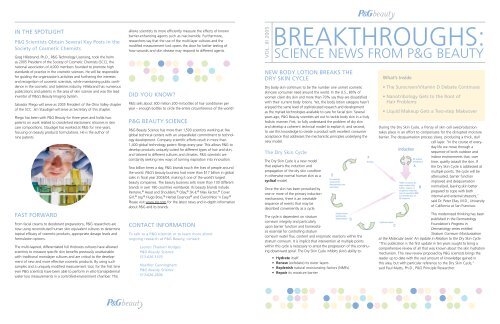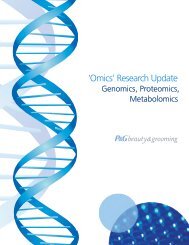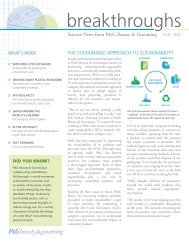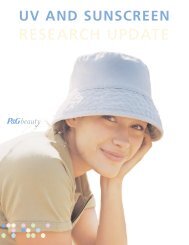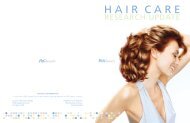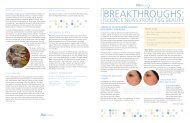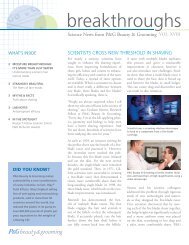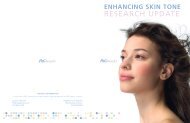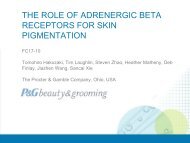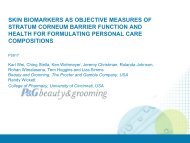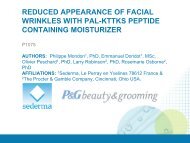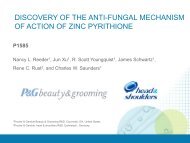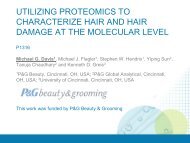BREAKTHROUGHS: - P&G Beauty & Grooming
BREAKTHROUGHS: - P&G Beauty & Grooming
BREAKTHROUGHS: - P&G Beauty & Grooming
You also want an ePaper? Increase the reach of your titles
YUMPU automatically turns print PDFs into web optimized ePapers that Google loves.
IN THE SPOTLIGHT<br />
P&G Scientists Obtain Several Key Posts in the<br />
Society of Cosmetic Chemists<br />
Greg Hillebrand, Ph.D., P&G Technology Licensing, took the helm<br />
as 2005 President of the Society of Cosmetic Chemists (SCC), the<br />
national association of 4,000 members founded to promote high<br />
standards of practice in the cosmetic sciences. He will be responsible<br />
for guiding the organization’s activities and furthering the interests<br />
and recognition of cosmetic scientists, while maintaining public confidence<br />
in the cosmetic and toiletries industry. Hillebrand has numerous<br />
publications and patents in the area of skin science and was the lead<br />
inventor of P&G’s <strong>Beauty</strong> Imaging System.<br />
Salvador Pliego will serve as 2005 President of the Ohio Valley chapter<br />
of the SCC. Jim Staudigel will serve as Secretary of this chapter.<br />
Pliego has been with P&G <strong>Beauty</strong> for three years and holds two<br />
patents on work related to crosslinked elastomeric silicones in skin<br />
care compositions. Staudigel has worked at P&G for nine years,<br />
focusing on beauty products formulations. He is the author of<br />
nine patents.<br />
FAST FORWARD<br />
From facial creams to deodorant preparations, P&G researchers are<br />
now using reconstituted human skin equivalent cultures to determine<br />
topical efficacy of cosmetic products, appropriate dosage levels and<br />
formulation options.<br />
The multi-layered, differentiated full thickness cultures have allowed<br />
scientists to measure specific skin benefits previously unattainable<br />
with traditional monolayer cultures and are critical to the development<br />
of new and more effective cosmetic products. By using such<br />
samples and a uniquely modified measurement tool, for the first time<br />
ever P&G scientists have been able to perform in vitro transepidermal<br />
water loss measurements in a controlled-environment chamber. This<br />
allows scientists to more efficiently measure the effects of known<br />
barrier-enhancing agents such as niacinamide. Furthermore,<br />
researchers say that the use of the multi-layer cultures and the<br />
modified measurement tool opens the door for better testing of<br />
how wounds and skin disease may respond to different agents.<br />
DID YOU KNOW?<br />
P&G sells about 300 million 200-ml bottles of hair conditioner per<br />
year – enough bottles to circle the entire circumference of the world!<br />
P&G BEAUTY SCIENCE<br />
P&G <strong>Beauty</strong> Science has more than 1,500 scientists working at five<br />
global technical centers with an unparalleled commitment to technology<br />
development. Company scientific efforts result in more than<br />
1,400 global technology patent filings every year. This allows P&G to<br />
develop products uniquely suited for different types of hair and skin,<br />
and tailored to different cultures and climates. P&G scientists are<br />
constantly seeking new ways of turning inspiration into innovation.<br />
Two billion times a day, P&G brands touch the lives of people around<br />
the world. P&G’s beauty business had more than $17 billion in global<br />
sales in fiscal year 2003/04, making it one of the world’s largest<br />
beauty companies. The beauty business sells more than 130 different<br />
brands in over 180 countries worldwide. Its beauty brands include<br />
Pantene, ® Head and Shoulders, ® Olay, ® SK-II, ® Max Factor, ® Cover<br />
Girl, ® Joy, ® Hugo Boss, ® Herbal Essences ® and Clairol Nice ‘n Easy. ®<br />
Please visit www.pg.com for the latest news and in-depth information<br />
about P&G and its brands.<br />
CONTACT INFORMATION<br />
To talk to a P&G scientist or to learn more about<br />
ongoing research at P&G <strong>Beauty</strong>, contact:<br />
Lauren Thaman Hodges<br />
P&G <strong>Beauty</strong> Science<br />
513-626-1370<br />
Heather Cunningham<br />
P&G <strong>Beauty</strong> Science<br />
513-626-2606<br />
VOL. III 2005<br />
<strong>BREAKTHROUGHS</strong>:<br />
SCIENCE NEWS FROM P&G BEAUTY<br />
NEW BODY LOTION BREAKS THE<br />
DRY SKIN CYCLE<br />
Dry body skin continues to be the number one unmet cosmetic<br />
skincare consumer need around the world. In the U.S., 80% of<br />
women claim dry skin and more than 70% say they are dissatisfied<br />
with their current body lotions. Yet, the body lotion category hasn’t<br />
enjoyed the same level of sophisticated research and development<br />
as the myriad technologies available to care for facial skin. Several<br />
years ago, P&G <strong>Beauty</strong> scientists set out to tackle body skin in a truly<br />
holistic manner. First, to fully understand the problem of dry skin<br />
and develop a coherent technical model to explain it; and second,<br />
to use this knowledge to create a product with excellent consumer<br />
acceptance that addresses the mechanistic principles underlying the<br />
new model.<br />
The Dry Skin Cycle<br />
The Dry Skin Cycle is a new model<br />
that explains the induction and<br />
propagation of the dry skin condition<br />
in otherwise normal human skin as a<br />
cyclical model.<br />
Once the skin has been provoked by<br />
one or more of the primary induction<br />
mechanisms, there is an inevitable<br />
sequence of events that may be<br />
described conveniently as a cycle.<br />
The cycle is dependent on stratum<br />
corneum integrity and particularly<br />
upon barrier function and homeostasis<br />
essential for controlling stratum<br />
corneum water flux, content and enzymatic reactions within the<br />
stratum corneum. It is implicit that intervention at multiple points<br />
within this cycle is necessary to arrest the progression of this continuing<br />
downward spiral. The Dry Skin Cycle inhibits skin’s ability to:<br />
• Hydrate itself<br />
• Renew (exfoliate) its outer layers<br />
• Replenish natural moisturizing factors (NMFs)<br />
• Repair its moisture barrier<br />
What’s Inside<br />
• The Sunscreen/Vitamin D Debate Continues<br />
• Nanotribology Gets to the Root of<br />
Hair Problems<br />
• Liquid Makeup Gets a Two-step Makeover<br />
During the Dry Skin Cycle, a frenzy of skin cell overproduction<br />
takes place in an effort to compensate for the disrupted moisture<br />
barrier. The desquamation process slows, producing a thick, dull<br />
cell layer. “In the course of everyday<br />
life we move through a<br />
sequence of both outdoor and<br />
indoor environments that, over<br />
time, quietly assault the skin. If<br />
the Dry Skin Cycle is addressed at<br />
multiple points, the cycle will be<br />
attenuated, barrier function<br />
improved and desquamation<br />
normalized, leaving skin better<br />
prepared to cope with both<br />
internal and external stressors,”<br />
said Dr. Peter Elias, M.D., University<br />
of California at San Francisco.<br />
This modernized thinking has been<br />
published in the Dermatology<br />
Foundation’s Progress in<br />
Dermatology series entitled<br />
Stratum Corneum Moisturization<br />
at the Molecular Level: An Update in Relation to the Dry Skin Cycle.<br />
“This publication is the first update in ten years sought to bring a<br />
comprehensive review of all that was known about the skin hydration<br />
mechanism. This new review proposed by P&G scientists brings the<br />
reader up to date with the vast amount of knowledge gained in<br />
this area, but with particular reference to the Dry Skin Cycle,”<br />
said Paul Matts, Ph.D., P&G Principle Researcher.
Proprietary Formulation Breaks the Cycle<br />
In order to break the cycle of dry skin, P&G scientists created a unique<br />
High Efficacy Body Moisturizer (HEBM) formulation that synergizes<br />
the power of niacinamide, glycerin and seven amino acids (NMFs),<br />
found naturally in skin, to help interrupt and reverse the cycle of dry<br />
skin. An innovative new delivery system using encapsulated microsensor<br />
particles allows for high levels of active ingredients without the<br />
traditional trade-off of heavy, sticky and tacky feel. This leads to high<br />
consumer acceptance and ongoing compliance.<br />
In clinical tests the HEBM formula was able to target the barrier<br />
improvement itself, not merely the skin symptoms. The HEBM was<br />
able to significantly improve the skin’s ability to augment the natural<br />
moisturizing factor and maintain stratum barrier structure even<br />
post-insult, indicating an intervention in the self-perpetuating dry<br />
skin degenerative process.<br />
Dr. Paul Matts is a Principle Researcher<br />
at P&G and author of the Dry Skin<br />
Cycle. His passion is the development<br />
of breakthrough methodologies to<br />
measure skin. His work has led to<br />
improvements in the formulations of<br />
P&G’s skin care products to alleviate<br />
dry skin and other skin conditions.<br />
SUNSCREEN CLEARED FROM BEING<br />
CULPRIT IN VITAMIN D DEFICIENCY<br />
In the past several years, there has been much public debate about<br />
the importance of sunlight exposure for maintaining adequate levels<br />
of vitamin D, versus the importance of daily protection against solar<br />
ultraviolet (UV) radiation. Vitamin D is known to play an important<br />
role in bone health and maintaining muscle control. Further studies<br />
have suggested that it plays a role in lowering blood pressure and<br />
reducing the risk of developing cancer, multiple sclerosis and arthritis.<br />
Vitamin D is provided in the diet, often at inadequate levels. The<br />
other major source of vitamin D is by the skin, following exposure to<br />
sunlight. However, it is well documented that even small amounts of<br />
solar UV can produce acute and chronic skin damage, including skin<br />
cancer. As a result of these benefits and risks, people have heard<br />
confusing advice to forego use of sunscreens and even intentionally<br />
sunbathe to avoid a vitamin D deficiency.<br />
A new study is helping to set the record straight about sunscreen<br />
use and vitamin D. At the 2005 American Academy of Dermatology<br />
(ADD) annual meeting, P&G scientists in collaboration with Dr. Darrell<br />
Rigel, Clinical Professor of Dermatology at NYU, reported the impact<br />
of “safe sun strategy” on levels of vitamin D in humans. This study<br />
determined the average daily “dose” of solar UV in 92 female<br />
subjects from 5 geographically distinct cities throughout the U.S.<br />
The dose of UV was used to calculate the production of vitamin D in<br />
the presence and absence of SPF 15 sunscreen.<br />
“We can estimate how much vitamin D is produced in the skin by<br />
a given dose of solar UV. Further, we know that SPF 15 sunscreen<br />
reduces the dose of erythemically weighted solar UV by 93%.<br />
Therefore, we can calculate the impact of daily use of SPF 15<br />
sunscreen on the levels of vitamin D,” said J Nash, Ph.D., a P&G<br />
<strong>Beauty</strong> scientist and study author. Using the most conservative<br />
assumptions, the estimated synthesis of vitamin D was equivalent<br />
to half the adequate intake even if SPF 15 sunscreen was applied<br />
properly. This production of vitamin D, together with current<br />
estimates of dietary intake, suggests that use of sunscreens would<br />
not produce a deficiency.<br />
These results do not refute the benefits of a “safe sun strategy,”<br />
including the use of SPF 15 sunscreen. Dr. Rigel recommends that<br />
people concerned with maintaining vitamin D levels should take<br />
a multivitamin, drink vitamin D-fortified milk or eat food rich in<br />
vitamin D, such as salmon. Daily use of SPF 15 sunscreen is strongly<br />
recommended by the AAD to diminish the long-term health effects<br />
of solar UV.<br />
STRANGELY BEAUTIFUL<br />
Healthy hair is sought after by people of all ethnicities. The damage<br />
posed to hair can be decreased or eliminated with a better understanding<br />
of the hair surface. With research grants from P&G <strong>Beauty</strong><br />
and the National Science Foundation, Dr. Bharat Bhushan, Nanotribology<br />
Laboratory for Information Storage and MEMS/NEMS (NLIM),<br />
has conducted nanotribological studies using atomic force/lateral<br />
force microscopy (AFM/LFM) to characterize samples that included<br />
African, Asian and Caucasian hair. While the results are not surprising,<br />
it is known that the ability to characterize the morphological,<br />
frictional and adhesive properties (otherwise known as the tribological<br />
properties) of hair is essential to advance science in this area.<br />
Virgin<br />
Virgin<br />
Virgin<br />
Caucasian hair<br />
Damaged<br />
Asian hair<br />
African hair<br />
Damaged<br />
Damaged<br />
MYTHS AND FACTS<br />
Images taken using AFM<br />
techniques demonstrate<br />
the significant differences<br />
seen between virgin<br />
and damaged samples<br />
of Caucasian, Asian and<br />
African hair, respectively.<br />
Cracking and pitting<br />
on the surface can<br />
occur even in virgin<br />
hair. In damaged hair,<br />
alternating regions of<br />
intact cuticle and severe<br />
wear are present.<br />
• The majority of women in the U.S. apply a body lotion<br />
every day. False – According to a survey of dermatologists,<br />
the majority believe that less than half of their adult female<br />
patients apply moisturizing lotion within three minutes<br />
after showering, as is recommended for maximum moisturizing<br />
benefit. i More than 80% of the dermatologists<br />
surveyed cited inconvenience as a key factor contributing<br />
to the low compliance rate. ii<br />
• For older women with dry skin, the type of cleanser used<br />
can impact dry skin as much as a moisturizer. True – Studies<br />
have shown moisturizing body washes can help restore<br />
moisture to aged skin. P&G researchers found that using<br />
a moisturizing body wash as opposed to bar soap can<br />
reduce the potential for skin drying on elderly skin.<br />
i, ii Ertel K, Farris R, Rodriguez V, Hartwig P. Body moisturizer usage compliance and its impact on dry skin improvement<br />
[abstract]. J Am Acad Dermatol. 2005; 52(3 Suppl):P85.<br />
CLOSE-UP<br />
A recent global study showed that 80% of women desire a<br />
long-wear benefit from their makeup. To solve this problem, P&G<br />
scientists developed a new two-step liquid makeup system that<br />
provides continuous coverage for 10 hours, even under hot and<br />
humid conditions. The moisturizing basecoat (or PrepStep) employs<br />
waterproofing polymers previously unseen in cosmetics to help<br />
Thin Film<br />
Thickness = Lower<br />
Coverage of Skin<br />
More Uniform<br />
Pigmented Film<br />
Thick Film<br />
Thickness = Higher<br />
Coverage Area<br />
Coverage achieved by traditional foundation (top)<br />
versus two-step liquid makeup (bottom).<br />
LAB NOTES<br />
protect the color coat<br />
from sweat and<br />
sebum. The result is<br />
flawless color that<br />
does not fade or settle<br />
into pores and fine<br />
lines, thus evening out<br />
the skin’s tone for a<br />
fresh, natural look that<br />
lasts and lasts.<br />
Dandruff affects over 50% of the adult population, with some studies<br />
suggesting an incidence rate of up to 80%. An astounding 36%<br />
of dandruff sufferers also experience sensitive scalp. While almost all<br />
dandruff sufferers have tried an anti-dandruff shampoo, only onethird<br />
use these products regularly, citing greasy hair and sensitive<br />
scalp as common culprits for discontinued use. P&G <strong>Beauty</strong> scientists<br />
conducted extensive research to develop a dandruff shampoo with<br />
a modified PTZ (pyrithione zinc) formula without dyes or strong<br />
fragrances and with a rebalanced preservative system for individuals<br />
with perceived sensitive scalp. Consumer studies demonstrate that<br />
the new PTZ formulation is effective against dandruff and provides<br />
significant relief from dryness and itch. Clinical research shows it is<br />
as gentle to sensitive scalps as children’s shampoo.<br />
GLOBAL BEAUTY<br />
Mixing/Emulsifying Region<br />
Provides Pigment Adhesion<br />
Women worldwide are concerned with the effects of aging on facial<br />
skin, including fine lines, wrinkles, poor texture and hyperpigmentation,<br />
most of which are caused by repeated sun exposure over many<br />
years. Previous studies of niacinamide, also known as vitamin B3,<br />
revealed its benefits in treating these age-related problems. New testing<br />
shows that niacinamide can also help treat skin yellowing, a top<br />
beauty concern among Asian women, where lighter skin is considered<br />
most desirable. Niacinamide has been shown to inhibit glycation –<br />
a chemical process that deteriorates collagen in the skin over time<br />
causing yellowing – making it an effective treatment for this problem.


